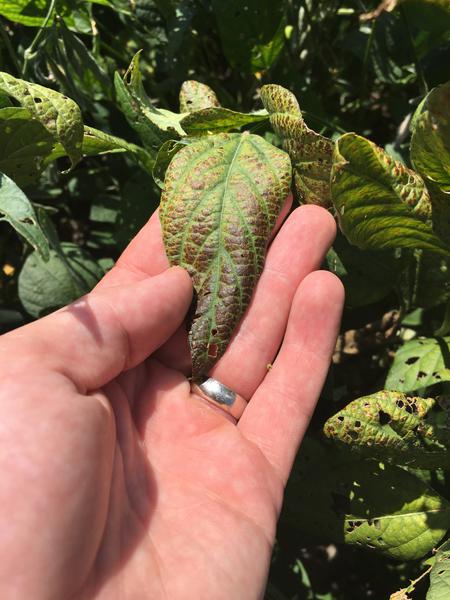Introduction
Cercospora leaf blight is a foliar disease caused by the pathogen Cercospora kikuchii, the causal agent of purple seed stain. Although this disease is common in soybean, it rarely causes significant yield losses to North Carolina producers.
Pathogen
Cercospora kikuchii is the causal pathogen of Cercospora leaf blight and purple seed stain in soybean. The asexual stage of this fungus is important for disease in soybean, and C. kikuchii reproduces on the surface of affected leaves under warm, humid conditions. C. kikuchii spores are spread through wind and rain to other plants. In high humidity and heat, C. kikuchii spores germinate and infect susceptible soybean plants. In the presence of light, the pathogen produces a toxin called cercosporin, which is responsible for the purple-bronze discoloration on the leaf surface.
Symptoms
Diseased leaves will yellow and can have a bronze or purple tint (Figure 1). The darker discoloration is due to a light-dependent toxin produced by C. kikuchii (cercosporin) that causes plant cells to rupture and die. As the disease progresses small, dark spots will appear along major leaf veins and petioles and eventually the leaf will wrinkle and become tough. Soybean pods can also be infected by C. kikuchii, causing a disease called purple seed stain.
Disease Cycle and Conditions Favorable for Disease
C. kikuchii survives in leftover, infected crop debris in soybean fields or in alternative weed hosts. Wind and water disperse spores from crop debris and other hosts onto young, susceptible soybean plants. Under hot and humid conditions, foliar symptoms appear in the upper canopy leaves and petioles. The infected leaves will eventually blight due to widespread leaf lesion development and fall to the ground. The leftover infected crop debris will be the inoculum for the subsequent year’s crop.
Management
Cultural practices and chemical management are both options for Cercospora leaf blight management. Crop rotation systems incorporating non-host plants such as corn or small grains can reduce inoculum in crop residue and disrupt the disease cycle. Tillage is also an option to reduce inoculum levels in the field.
Soybean varieties vary in their response to C. kikuchii, but none are completely resistant to the pathogen. Fungicides may be used to reduce disease observed in the field, but their use has not been shown to be effective to reduce purple seed stain. Fungicide efficacy ratings can be found on the soybean extension portal and are updated annually. Fungicide classes should be rotated to avoid fungicide resistance development. Many species of Cercospora have been reported to develop QoI fungicide resistance, and the Fungicide Action Resistance Committee (FRAC) lists C. kikuchii as a medium risk for developing fungicide resistance.
Useful Resources
The NC State University Plant Disease and Insect Clinic provides diagnostics and control recommendations.
The NC State Extension Plant Pathology portal provides information on crop disease management.
The North Carolina Agricultural Chemicals Manual provides pesticide information for common diseases of North Carolina. The manual recommendations do not replace those described on the pesticide label, and the label must be followed.
Acknowledgements
This factsheet was prepared by the NC State University Field Crops and Tobacco Pathology Lab in 2020.
- Check out our Facebook and our Twitter!
Publication date: Sept. 3, 2020
N.C. Cooperative Extension prohibits discrimination and harassment regardless of age, color, disability, family and marital status, gender identity, national origin, political beliefs, race, religion, sex (including pregnancy), sexual orientation and veteran status.
NC Cooperative Extension prohíbe la discriminación por raza, color, nacionalidad, edad, sexo (incluyendo el embarazo), discapacidad, religión, orientación sexual, identidad de género, información genética, afiliación política, y estatus de veteran.
The use of brand names in this publication does not imply endorsement by NC State University or N.C. A&T State University of the products or services named nor discrimination against similar products or services not mentioned.
Recommendations for the use of agricultural chemicals are included in this publication as a convenience to the reader. The use of brand names and any mention or listing of commercial products or services in this publication does not imply endorsement by NC State University or N.C. A&T State University nor discrimination against similar products or services not mentioned. Individuals who use agricultural chemicals are responsible for ensuring that the intended use complies with current regulations and conforms to the product label. Be sure to obtain current information about usage regulations and examine a current product label before applying any chemical. For assistance, contact your local N.C. Cooperative Extension county center.
N.C. Cooperative Extension prohibits discrimination and harassment regardless of age, color, disability, family and marital status, gender identity, national origin, political beliefs, race, religion, sex (including pregnancy), sexual orientation and veteran status.

